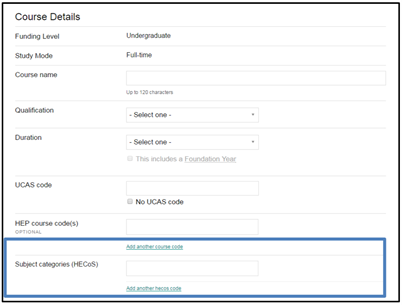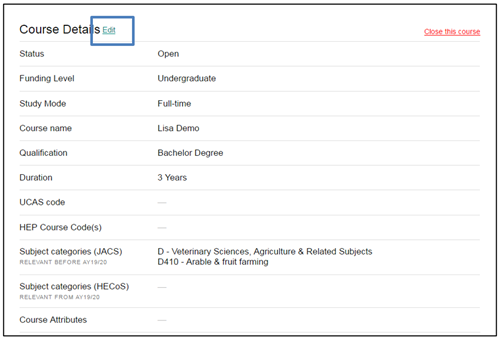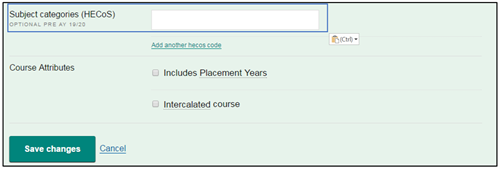Version 1.0 - Last Updated: 08 Jul 2025
Course Details
Subject category (HECoS)
This is a mandatory field for all courses.
It is a 6-digit code in the Higher Education Classification of Subjects (HECoS).
CMS will show HECoS codes that match the code you are entering. Select the correct code when you see it. You can enter up to 5 subject categories for each course.
What are HECoS codes used for?
From AY 2019/20 a new subject coding system replaced JACS codes. This is known as the Higher Education Classification of Subjects (HECoS).
HECoS describes the subject content of courses at UK higher education providers.
The Higher Education Statistics Agency (HESA) developed HECoS to randomly generate code identifiers and avoid the coding frame running out of space.
You can find more detailed information about HECoS on the HESA website. They also have guidance on how to add the correct HECoS codes to your courses.
The subject is a generic classification. It does not show the level of study and is only meant to capture the subject of the course. We use the same list for courses at any level: undergraduate, postgraduate and continuing education programmes.
You can record up to 5 subject categories against a single course if needed. For example, a Bachelor’s Degree in Geography and Mathematics would have 2 subject categories, one for geography and one for mathematics.
We use HECoS codes to determine a student’s entitlement. We also use them to tell which part-time courses are exempt from the Equivalent or Lower Qualification (ELQ) rule.
It is very important that the HECoS codes you enter are correct to the best of your knowledge. An incorrect HECoS code can have a significant effect on a student’s level of funding.
Adding a HECoS code to a new course
New courses from AY 2019/20 no longer need a JACS code but do need a HECoS code.
Use the Subject categories (HECoS) field in the Course Details section of CMS to enter the HECoS code.

CMS will check that you enter a recognised HECoS code. For example, the code must have 6 digits. It must also be compatible with the Common Aggregation Hierarchy on the HESA website.
If you need to add more codes, select Add another HECoS code. Each code must be unique. CMS will not let you save a course that has 2 or more identical HECoS codes.
Always check that the HECoS codes are correct before you save the course. An incorrect code could stop a student from accessing funding.
Once you have entered the HECoS codes and are happy they are correct, select Save changes under the Course Attributes section. You can then move on to updating the rest of the course details in the Academic Year section.
If you need to change the HECoS code after you have saved the course, contact our Partners Support Desk.
Adding a HECoS code to a copied course
If you are copying an existing course from a previous academic year, you will need to enter a HECoS code.
When you start updating the copied course details, you will notice that the JACS field is no longer visible. You will see the Subject categories (HECoS) field instead. The JACS code will not be included, as you are creating a new course.
Follow the instructions under Adding a HECoS code to a new course to include the HECoS codes with your copied course.
Adding a HECoS code to an existing course
When you update a course that did not have a HECoS code before, you must enter the HECoS code before you can save the course. Update the HECoS code first before you make any updates to the Academic Year section.
To add a HECoS code, open the existing course. On the Course Details page, you will now see a field called Subject categories (HECoS).
To enter HECoS codes, select the Edit link at the top of the page.

This opens a free text field where you can enter the HECoS code.

CMS will check that you enter a recognised HECoS code. For example, the code must have 6 digits. It must also be compatible with the Common Aggregation Hierarchy on the HESA website.
If you need to add more codes, select Add another HECoS code. Each code must be unique. CMS will not let you save a course that has 2 or more identical HECoS codes.
Always check that the HECoS codes are correct before you save the course. An incorrect code could stop a student from accessing funding.
Once you have entered the HECoS codes and are happy they are correct, select Save changes under the Course Attributes section. You can then move on to updating the rest of the course details in the Academic Year section.
If you need to change the HECoS code after you have saved the course, contact our Partners Support Desk.
JACS to HECoS mapping: error scenarios
HECoS was developed in part to provide more robust coding and to address inconsistencies in the JACS framework. It has allowed for courses to be more accurately categorised. This means that some courses now fall under a different, more accurate subject category.
For example, Hair and Beauty Science has moved from 'subjects allied to medicine' to 'biological and sport sciences'.
Courses in the 'medicine and dentistry' and 'subjects allied to medicine' categories may have attributes that affect a student’s entitlement. It is thus very important that you apply the correct course attributes when you map a JACS code to a HECoS code.
CMS includes validation for existing courses in the 'medicine and dentistry' and 'subjects allied to medicine' categories. This helps to ensure they have an accurate HECoS code.
You should pay close attention to courses that have a 'medicine and dentistry' or 'subjects allied to medicine' JACS code and have course attributes set up. For example, they might have the Attracts NHS Bursary attribute. Make sure to enter an equivalent HECoS code to these courses.
The same applies to courses that the HECoS mapping system puts in the 'medicine and dentistry' or 'subjects allied to medicine' categories even if they do not have a corresponding JACS code.
The following scenarios show how this can apply to your existing courses.
Scenario 1
The JACS code is not a 'medicine and dentistry' or 'subjects allied to medicine' code.
The course does not have medical attributes (such as NHS Bursary or Pre-registration).
The HECoS code is a 'medicine and dentistry' or 'subjects allied to medicine' code.
CMS will let you save the course as it does not currently have any medical course attributes.
This also means that while it is now categorised under 'medicine and dentistry' or 'subjects allied to medicine' you will not see the option to add medical course attributes.
If your course has a medical attribute such as Pre-registration or Attracts NHS Bursary, you should contact our Partners Support Desk immediately. The support desk will tell you what you need to do to ensure your course is updated correctly. This helps to make sure that your students receive the correct level of funding.
Scenario 2
The JACS code is a 'medicine and dentistry' or 'subjects allied to medicine' code.
The course has medical attributes set up (for example NHS Bursary or Pre-registration).
The HECoS code is not a 'medicine and dentistry' or 'subjects allied to medicine' code.
CMS will not let you save this course.
You cannot have a course with a medical attribute that does not have a 'medicine and dentistry' or 'subjects allied to medicine' HECoS code.
When you try to save the course, CMS will show an error message.
You should contact our Partners Support Desk. The support desk will tell you what you need to do to ensure your course is updated correctly.
Scenario 3
The qualification is postgraduate healthcare.
The JACS code is a 'medicine and dentistry' or 'subjects allied to medicine' code.
The HECoS code is not a 'medicine and dentistry' or 'subjects allied to medicine' code.
CMS will not let you save this course.
For postgraduate healthcare courses, the HECoS code must fall under the 'subjects allied to medicine' category.
CMS will not let you save a postgraduate healthcare course until one of the HECoS codes you have entered is a 'subjects allied to medicine' code.
Likewise, when you create a new postgraduate healthcare course, its HECoS code needs to be a 'subjects allied to medicine' code.
Scenario 4
The JACS code is not a 'medicine and dentistry' or 'subjects allied to medicine' code.
The course does not have any medical attributes (such as NHS Bursary or Pre-registration).
The HECoS code is not a 'medicine and dentistry' or 'subjects allied to medicine' code.
CMS will let you save the course.
There is a link between the subject category you select and the healthcare-related course attributes. Only courses set up with a subject category of Medicine, Dentistry or Subjects Allied to Medicine can have one or more of the following healthcare attributes checked:
- Medicine/Dentistry
- NHS Bursary
- Paramedic course
- Dental Hygiene/Therapy